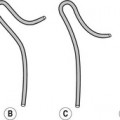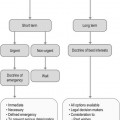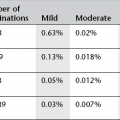Breast
Mammography
Indications
1. Focal signs in women aged >40 years in the context of triple (i.e. clinical, radiological and pathological) assessment at a specialist, multidisciplinary diagnostic breast clinic
2. Following diagnosis of breast cancer, to exclude multifocal/multicentric/bilateral disease
3. Breast cancer follow-up, no more frequently than annually or less frequently than biennially for at least 10 years
4. Population screening of asymptomatic women with screening interval of 3 years, in accordance with NHS Breast Screening Programme policy:
(a) By invitation, women aged 47–73 years in England, Northern Ireland and Wales and 50–70 years elsewhere in UK
(b) Women >73 years, by self-referral (there is no upper age limit)
5. Screening of women with a moderate/high risk of familial breast cancer who have undergone genetic risk assessment in accordance with National Institute for Health and Clinical Excellence (NICE) guidance
6. Screening of a cohort of women who underwent the historical practice of mantle radiotherapy for treatment of Hodgkin’s disease when aged <30 years. These women have a breast cancer risk status comparable to the high-risk familial history group1
7. Investigation of metastatic malignancy of unknown origin.
Not indicated
1. Asymptomatic women without familial history of breast cancer, aged <40 years
2. Investigation of generalized signs/symptoms, e.g. cyclical mastalgia or non-focal pain/lumpiness
3. Prior to commencement of hormone replacement therapy
4. To assess the integrity of silicone implants
5. Individuals affected by ataxia-telangiectasia mutated (ATM) gene mutation with resultant high sensitivity to radiation exposure, including medical X-rays
6. Routine investigation of gynaecomastia.
Equipment
Conventional film-screen mammographic technology has largely been superseded by full-field digital mammography (FFDM) which has a higher sensitivity in:
Ongoing developments of FFDM include:
1. Tomosynthesis which creates a single three-dimensional image of the breast by combining data from a series of two-dimensional radiographs acquired during a single sweep of the X-ray tube. Ongoing studies suggest that this technique may improve diagnostic accuracy in screening of the order of 30%, reduce recall by an estimated 40% and has a radiation dose of approximately 50% of that of a single mammographic exposure
2. Contrast-enhanced digital mammography, i.e. angiomammography. Two approaches are being developed: temporal sequencing (in which images pre and post contrast are subtracted with a resultant angiomammogram) and dual energy imaging (in which imaging at low and high energies detailing, respectively, parenchyma and fat with and without iodine are obtained. The subsequent views can then be subtracted
3. Computer-aided detection (CAD) software can assist film reading by placing prompts over areas of potential mammographic concern. There is evidence that, even in the screening setting, single reading in association with CAD may offer sensitivities and specificities comparable to that of double reading.4
If conventional film-screen mammographic imaging is to be carried out, it should be performed on a dedicated unit which includes in its specification:
1. Dual-focus X-ray tube: 0.1/0.3 focal spot size
2. Dual filtration: molybdenum/rhodium
3. Choice of rotating target material: molybdenum/rhodium/tungsten
4. 18 × 24 cm and 24 × 30 cm interchangeable buckys
5. Automatic/semi-automatic and manual exposure control
6. Carbon fibre table top assembly with reciprocating or oscillating grid, average grid ratio 5 : 1
7. Magnification assembly; magnification factors 1.8/2.0
8. Contact spot compression.
Technique
Standard mammographic examination comprises imaging of both breasts in two views, namely the mediolateral oblique (MLO) and craniocaudal (CC) positions. Screening methodology is bilateral, two-view (MLO and CC) mammography at all screening rounds.
Additional views may be required to provide adequate visualization of specific anatomical sites:
Compression of the breast is an integral part of mammographic imaging resulting in:
1. Reduction in radiation dose
2. Immobilization of the breast, thus reducing blurring
3. Uniformity of breast thickness allowing even penetration
4. Reduction in breast thickness thus reducing scatter/noise achieving higher resolution.
Adaptation of the technique can provide additional information:
1. Spot compression, to remove overlapping composite tissue
2. Magnification (smaller focal spot combined with air-gap), to provide morphological analysis.
In the presence of subpectoral implants, the push back technique of Ecklund2 can aid visualization of breast tissue.
References
1. Hancock, SL, Tucker, MA, Hoppe, RT. Breast cancer after treatment of Hodgkin’s disease. J Natl Cancer Inst. 1993; 85:25–31.
2. Eklund, GW, Busby, RC, Miller, SH, et al. Improved imaging of the augmented breast. Am J Roentgenol. 1988; 151:469–473.
3. Pisano, ED, Gatsonis, C, Hendrick, E, et al. Diagnostic performance of digital versus film mammography for breast cancer screening. N Engl J Med. 2005; 353:1773–1783.
4. Gilbert, FJ, Astley, SM, McGee, MA, et al. Single reading with computer-aided detection and double reading of screening mammograms in the United Kingdom National Breast Screening Program. Radiology. 2006; 241:47–53.
Stay updated, free articles. Join our Telegram channel

Full access? Get Clinical Tree







